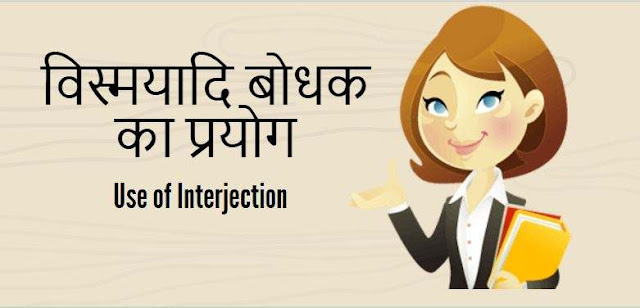विस्मयादि बोधक का प्रयोग – Use of Interjection

Contents
- 1 विस्मयादि बोधक का प्रयोग – Use of Interjection
- 1.1 विस्मयादि बोधक के भेद (Kinds of Interjection)
- 1.2 Use of Interjections (विस्मयादिबोधक अव्यय का प्रयोग)
- 1.3 Examples of Interjections & Their Uses
- 1.3.1 1. Interjections for Joy (खुशी व्यक्त करने के लिए)
- 1.3.2 2. Interjections for Surprise (आश्चर्य व्यक्त करने के लिए)
- 1.3.3 3. Interjections for Pain (दर्द या दुख व्यक्त करने के लिए)
- 1.3.4 4. Interjections for Calling Attention (ध्यान आकर्षित करने के लिए)
- 1.3.5 5. Interjections for Agreement or Disagreement (सहमति या असहमति व्यक्त करने के लिए)
- 1.3.6 6. Interjections for Greeting (अभिवादन के लिए)
- 1.4 Key Points to Remember (महत्वपूर्ण बातें)
- 1.5 Conclusion
विस्मयादि बोधक का प्रयोग – Use of Interjection
विस्मयादि बोधक के भेद (Kinds of Interjection)
Example- Hurrah!,Hush! , Ha-ha!, wow!,
Example – Alas!, Oh!, Ouch!, Ah! Ha!, Oops!,
Example –Ha!, What!, Hey!, Oh!,
Example –Bravo!, Brilliant!, Well done!,
Interjection for fear – जिन शब्दों का प्रयोग डर व्यक्त करने के लिए किया जाता है वहां Interjection for fear होता है
Use of Interjections (विस्मयादिबोधक अव्यय का प्रयोग)
What is an Interjection? (विस्मयादिबोधक अव्यय क्या है?)
An interjection is a word or phrase used to express sudden emotions or feelings such as joy, sorrow, surprise, pain, or excitement.
It is usually followed by an exclamation mark (!) or a comma (,).
In Hindi, विस्मयादिबोधक अव्यय वे शब्द होते हैं जो अचानक आने वाली भावनाओं को व्यक्त करते हैं।
Examples of Interjections & Their Uses
1. Interjections for Joy (खुशी व्यक्त करने के लिए)
Used to express happiness, excitement, or pleasure.
Examples:
-
Wow! You did an amazing job! (वाह! तुमने कमाल कर दिया!)
-
Hurray! We won the match. (हुर्रे! हमने मैच जीत लिया।)
-
Yippee! It’s my birthday today! (यिप्पी! आज मेरा जन्मदिन है!)
2. Interjections for Surprise (आश्चर्य व्यक्त करने के लिए)
Used to express shock, amazement, or wonder.
Examples:
-
Oh! I didn’t expect to see you here. (ओह! मैंने यहाँ तुम्हें देखने की उम्मीद नहीं की थी।)
-
What! Are you serious? (क्या! तुम सच कह रहे हो?)
-
Whoa! That was a fantastic goal! (वाह! वह शानदार गोल था!)
3. Interjections for Pain (दर्द या दुख व्यक्त करने के लिए)
Used when feeling pain, sadness, or grief.
Examples:
-
Ouch! That hurt a lot! (आह! यह बहुत दर्द हुआ!)
-
Alas! He lost his wallet. (हाय! उसका बटुआ खो गया।)
-
Oh no! I missed my flight. (ओह नहीं! मेरी फ्लाइट छूट गई।)
4. Interjections for Calling Attention (ध्यान आकर्षित करने के लिए)
Used to grab someone’s attention.
Examples:
-
Listen! I have something important to say. (सुनो! मुझे कुछ जरूरी बात कहनी है।)
-
Hey! Stop talking and focus. (अरे! बात करना बंद करो और ध्यान दो।)
-
Look! There’s a rainbow in the sky. (देखो! आसमान में इंद्रधनुष है।)
5. Interjections for Agreement or Disagreement (सहमति या असहमति व्यक्त करने के लिए)
Used to show approval or disagreement.
Examples:
-
Yes! I completely agree with you. (हाँ! मैं पूरी तरह सहमत हूँ।)
-
No! I don’t think that’s a good idea. (नहीं! मुझे नहीं लगता कि यह अच्छा विचार है।)
-
Hmm, let me think about it. (हम्म, मुझे इसके बारे में सोचने दो।)
6. Interjections for Greeting (अभिवादन के लिए)
Used to greet someone politely.
Examples:
-
Hello! How are you? (नमस्ते! आप कैसे हैं?)
-
Hi! Nice to meet you. (हाय! आपसे मिलकर अच्छा लगा।)
-
Goodbye! See you soon. (अलविदा! फिर मिलेंगे।)
Key Points to Remember (महत्वपूर्ण बातें)
Interjections do not have a grammatical function in a sentence.
They are used alone or at the beginning of a sentence.
They express emotions, not facts.
An exclamation mark (!) is often used for strong emotions.
Conclusion
Interjections add emotions to our speech and writing.
They make conversations more expressive and natural.
Examples: Wow! Ouch! Oh no! Hey! Hurray!
Would you like some practice exercises on interjections?
